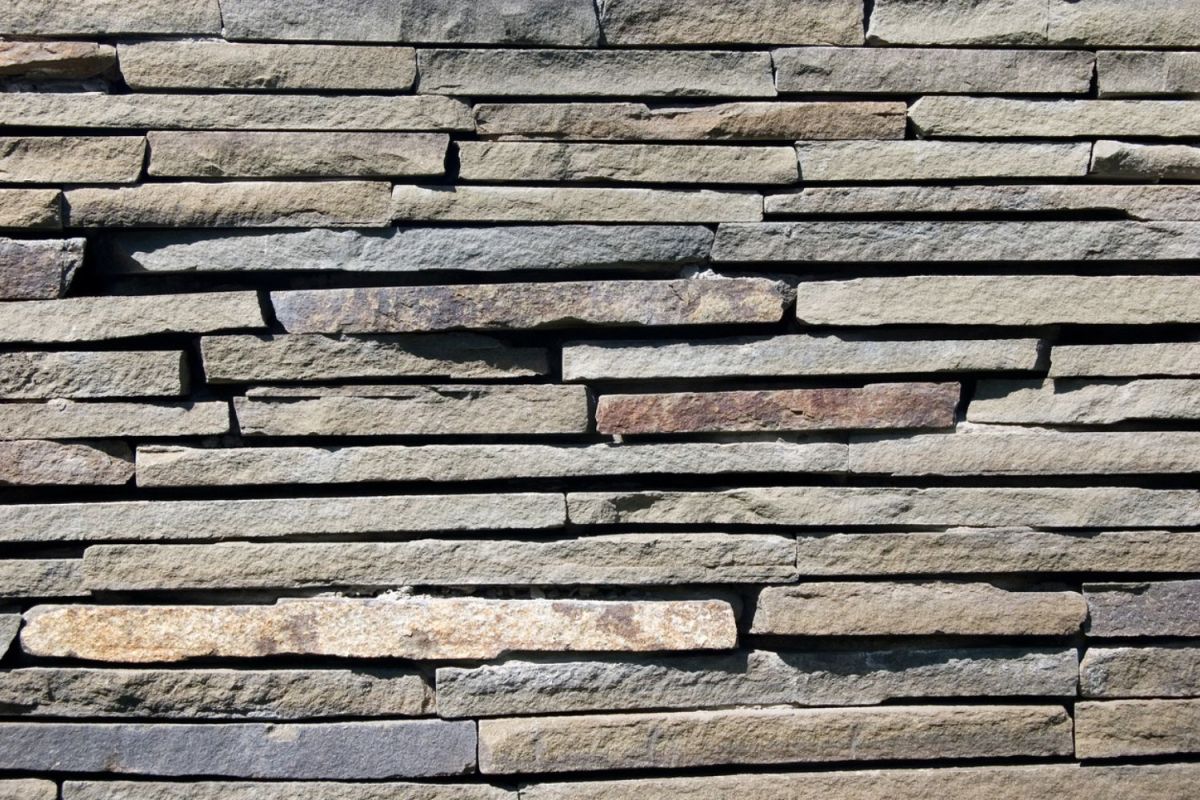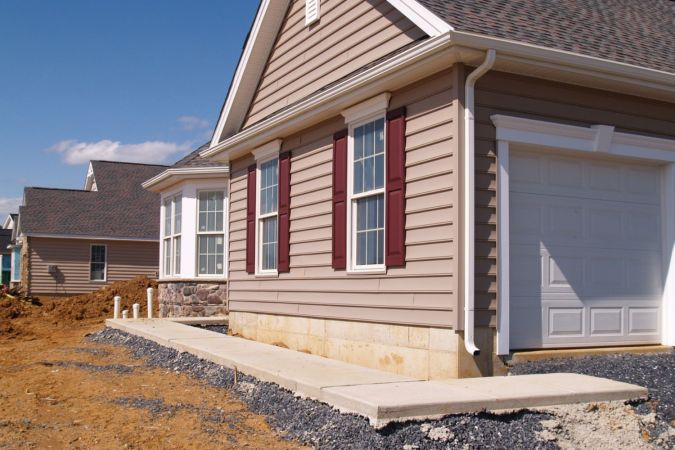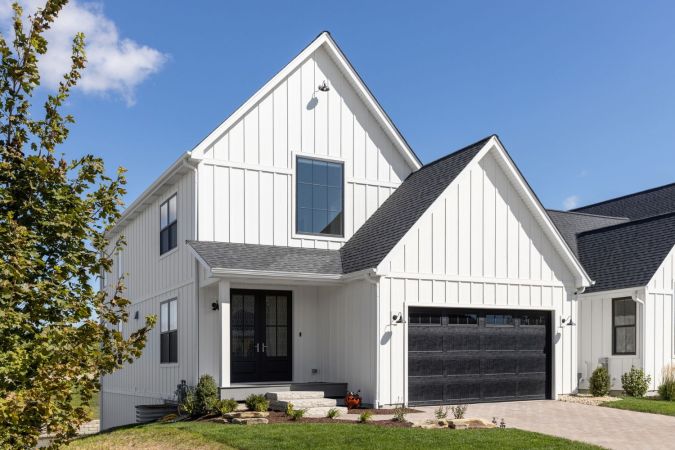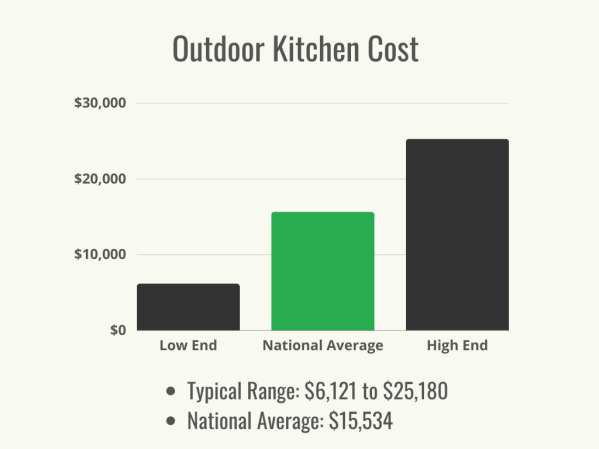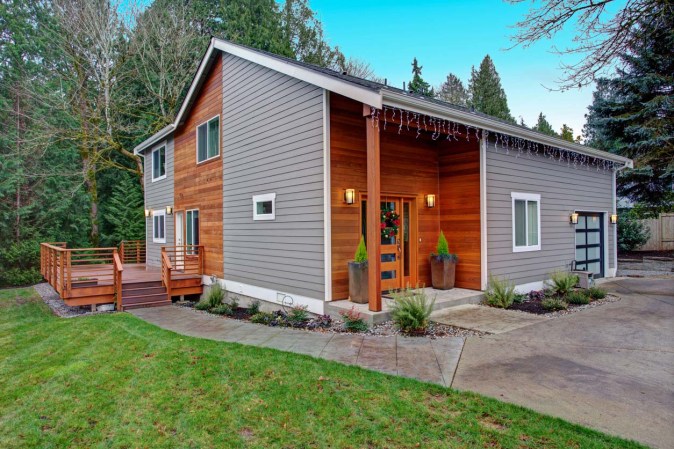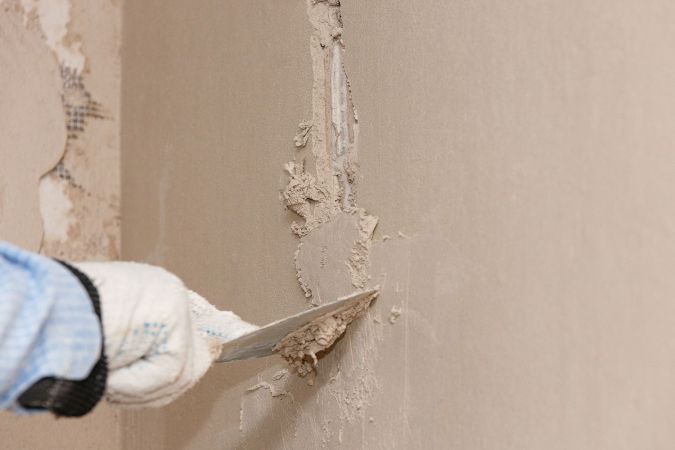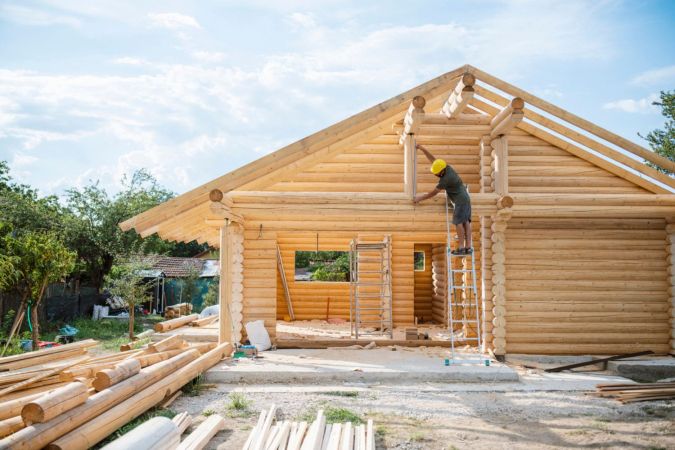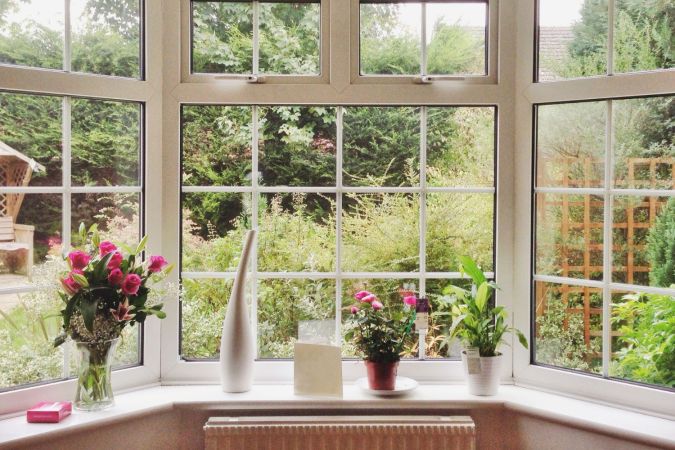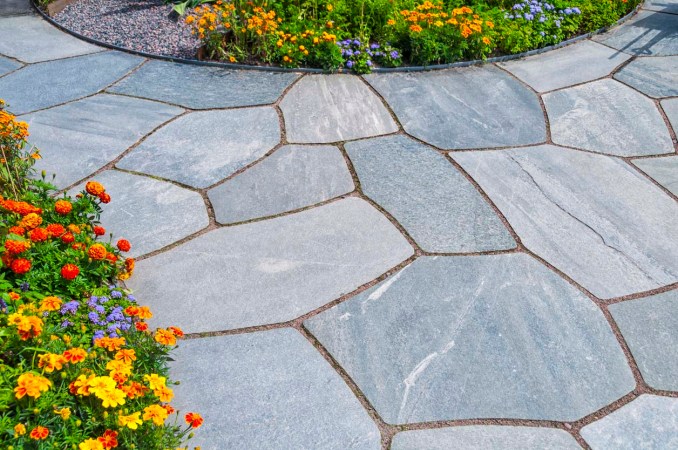We may earn revenue from the products available on this page and participate in affiliate programs. Learn More ›
Highlights
- The typical cost range to install stone veneer siding on a home is between $13,000 and $22,000, while the national average homeowners can expect to pay is $17,500.
- The total cost to install stone veneer siding will vary depending on the size of the home, the type and style of stone, the brand of stone, the required materials and supplies, the chosen finish, the cost of labor, and the installation location.
- Stone veneer siding offers numerous benefits, such as durability, affordability, energy efficiency, resistance to fire and impact, and low maintenance requirements.
- A homeowner with experience installing stone veneer siding may choose to complete this project themselves, but most homeowners will want to hire a siding professional to ensure the siding is installed correctly and that it won’t have issues due to improper installation.
The exterior of the home is intended to block out moisture, stand up to heavy wind, and help insulate the interior of the house. The exterior also serves as the face of the house, putting the homeowner’s aesthetic tastes and upkeep abilities on full display. When the exterior of the home is in poor condition or it is constructed with a weaker material, the interior of the home can become exposed to mold, mildew, and rot.
Stone veneer siding is a good option for homeowners to consider when it comes time to update the exterior of their home. According to Angi, homeowners can expect to spend about $13,000 to $22,000 for stone veneer siding installation, with an average cost of about $17,500. Homeowners can choose between natural stone veneer siding, manufactured stone veneer siding, or inexpensive faux stone veneer siding to give the home a new look. This guide can help homeowners better understand the various factors and additional expenses involved in determining the expected stone veneer siding cost.
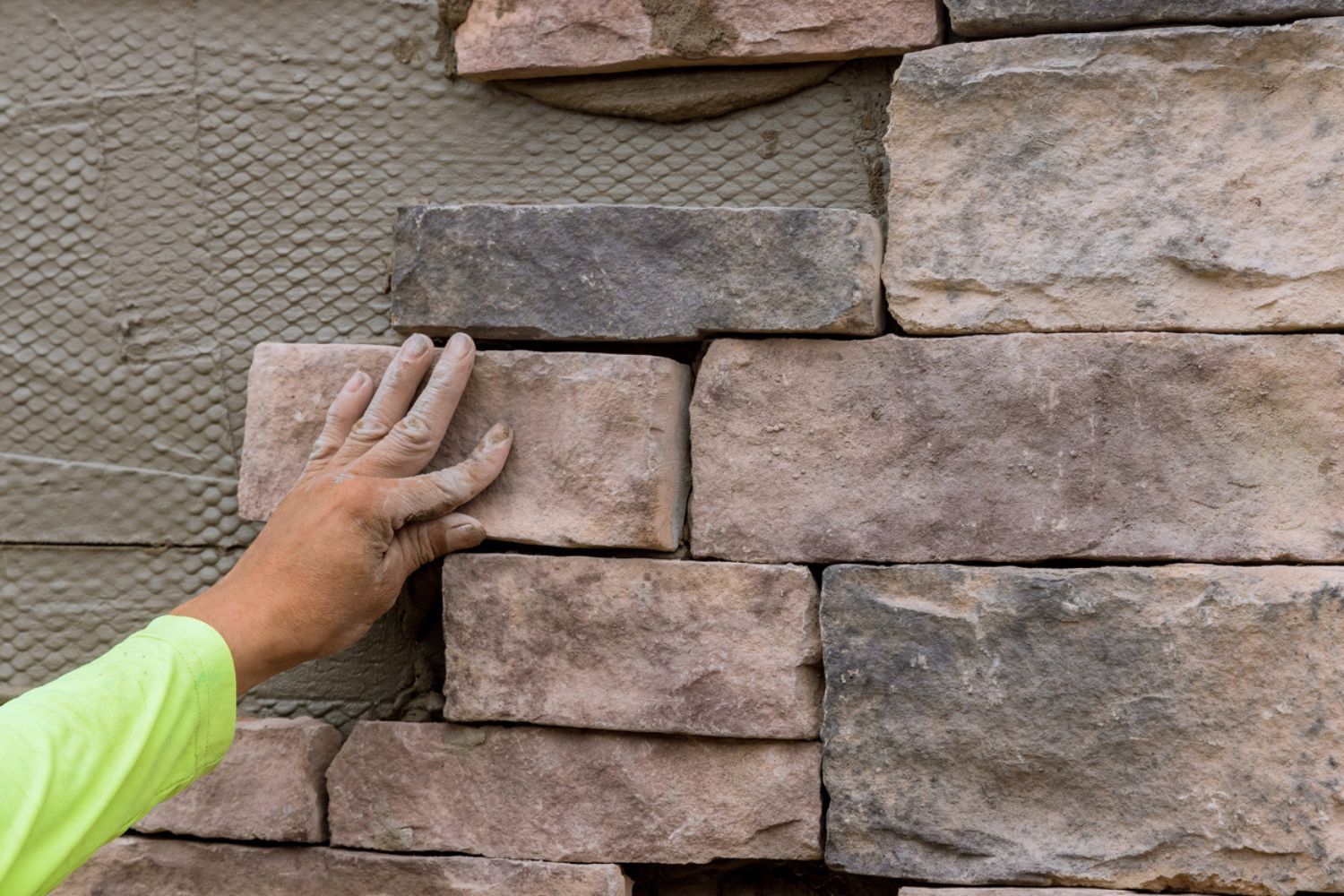
Factors in Calculating Stone Veneer Siding Cost
Given that the national average for exterior stone veneer siding installation is $17,500, it’s important for homeowners to understand the factors that can affect the stone veneer siding cost so they can put together an accurate budget for the project. Factors including home size, stone type, brand, labor rate, and even the installation location of the home can increase or decrease the overall house siding cost.
Home Size
One of the most important factors that affect the cost of installing stone veneer siding is the size of the home. Small homes don’t require as much material to replace the siding on the exterior of the house. Similarly, it will take more time and effort to install veneer siding over a larger area than it would to complete a stone veneer siding installation for a smaller home.
On average, stone veneer siding costs about $11 to $18 per square foot, though this price can fluctuate depending on whether the homeowner is using stone veneer siding panels or individual brick and stone veneer siding pieces. Homeowners will also want to keep in mind that this does not include the cost of labor, which can range from $6 to $24 per square foot based on the size and complexity of the project.
Stone Style and Type
The next cost factor for homeowners to take into consideration when drawing up the budget for an outdoor stone veneer siding project is the style and type of stone used for the job. Stone veneers are available in a range of different options. These include bulk pallets of stone veneer panels, individual stone veneer pieces, and even broad stone veneer sheets.
Similarly, there are several different modern stone veneer siding types, including basalt, granite, limestone, marble, sandstone, and slate. The cost of the stone veneer materials can differ depending on the type of siding. For instance, while slate costs just $4 to $11 per square foot, opting for granite can increase the cost to $8 to $21 per square foot. Homeowners will want to take some time to consider which stone style and type are right for their home and their budget.
Stone Brand
As with most other products, there can be some difference in the cost of stone veneer siding based on the manufacturer, so before choosing a stone veneer siding option for the installation, it’s recommended that homeowners research a few reputable brands to determine which manufacturer offers the best pricing and the top value for the siding material.
Depending on the stone brand, homeowners may pay anywhere from $4 to $42 per square foot for stone veneer siding. This pricing does not include the cost of labor, so unless the homeowner is planning a DIY stone veneer siding installation, then this material cost estimate will account for only about 50 percent of the project.
| Stone Veneer Brand | Average Cost per Square Foot (Materials Only) |
| AirStone | $6 to $8 |
| Black Bear | $6 to $9 |
| Cast Natural Stone | $6 to $7 |
| Centurion Stone | $4 to $6 |
| Eldorado Stone | $9 to $15 |
| GenStone | $11 to $42 |
| NextStone | $9 to $17 |
| Ply Gem | $5 to $11 |
| Silvermine Stone | $16 to $24 |
| Veneerstone | $11 to $15 |
Materials and Supplies
The cost of the stone veneer panels or individual stone veneer pieces is only one part of the total materials and supplies required for this project. Homeowners can also expect to pay for waterproofing materials, installation accessories, mortar, wire lathe, and some tools. If the homeowner is completing the stone veneer siding job on their own, these material costs will cover the purchase of the tools and supplies necessary for the installation.
Homeowners who hire a professional installation company may not see the individual items listed on the cost estimate or final bill, but the cost of these materials and supplies will ultimately be included in the total cost of the job.
| Materials and Supplies | Average Cost (Materials Only) |
| Individual stone veneer pieces | $8.15 to $10.85 per square foot |
| Installation accessories | $1.10 to $1.95 per linear foot |
| Mortar | $0.50 to $1.25 per square foot |
| Stone veneer panels | $11.65 to $17.75 per square foot |
| Trowel set | $12 to $30 |
| Water-resistive barrier and drainage mat | $1.45 to $2.60 per square foot |
| Wire lathe | $1.10 to $1.65 per square foot |
Finish
The type of siding affects the look and durability of the material used in the house siding installation project. However, the stone veneer can be further differentiated by the various textures and finishes in which these products are available, including flamed, honed, bush hammered, sandblasted, aged, tumbled, brushed, natural cleft, leather, and sawn.
The finish of the stone veneer doesn’t have a heavy impact on the cost, but it can change the aesthetic appearance of the home and offer other benefits, such as creating a nonslip surface that can be used on walkways or driveways. Finishes can also be helpful in creating a complementary exterior, like an aged stone veneer finish to keep consistency and uniformity with an aging home.
Labor
The labor involved with stone veneer siding jobs can be as much as 50 percent of the total cost of the project, so it’s necessary for homeowners to consider the local labor rate before hiring a company to complete this work. On average, the labor cost to install stone veneer siding ranges from about $6 to $24 per square foot, though this rate can increase if the contractors are working with complex and multilevel layouts.
It’s recommended that homeowners research at least three reputable stone veneer siding companies in the area to find a company that offers acceptable pricing and quality materials that fit their project budget. Getting an upfront estimate for the work is a good way to compare the offers between multiple companies, allowing the homeowner to have the necessary information to make an informed decision before proceeding.
Installation Location
Simple square or rectangle bungalow properties are the easiest homes to work with when homeowners are replacing the exterior siding. These houses do not have multiple stories and are made with a basic layout that is easy to plan and complete. However, the size and shape of a home can vary widely depending on the location.
With this in mind, the cost of the project will typically increase for 2- or 3-story homes. Similarly, houses with complex layouts will tend to take more time and may also require custom siding pieces to complete. Homeowners with complex or multilevel layouts can expect to pay about 25 percent to 35 percent more in labor for a stone veneer siding project.
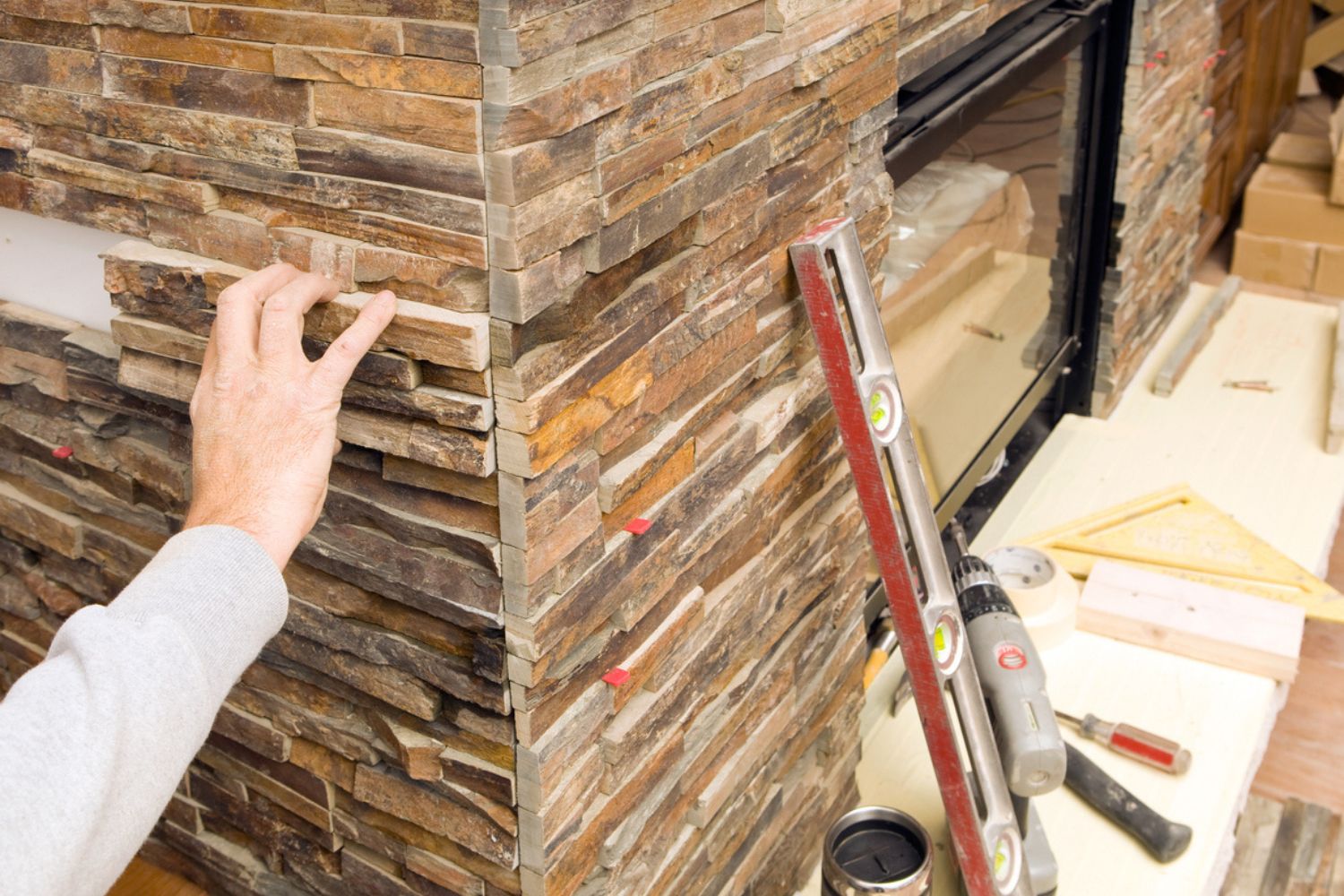
Additional Costs and Considerations
While the primary focus of a renovation budget should be the materials and labor required for the initial installation, there are additional factors for homeowners to keep in mind, including the costs to paint, weatherproof, replace underlayment, or remove the existing siding. Homeowners will want to consider these additional factors to ensure they are not blindsided by unexpected associated costs.
Partial vs. Full Exterior Installation
When it comes to exterior siding renovations, there are two main installation options, including partial exterior siding installation and full exterior siding installation.
- Partial exterior siding installation is more affordable than full exterior siding installation, costing about $2,000 to $9,000 for the entire front of the house or about $1,300 to $5,000 for a half-stone and half-vinyl installation.
- Full exterior siding installation is the more costly choice, ranging from about $15,000 to $35,000 on average. During this type of installation, the contractors will remove all existing siding and replace the siding for the front, back, and sides of the home. The cost of this project can greatly exceed the cost of a partial siding installation, depending on the size and layout of the home.
Existing Siding Removal
Before the stone veneer siding can be installed, the contractors or the homeowner will need to remove the existing siding. While installing stone veneer over wood siding can work, this is not an easy task and could create issues in the future, so it’s best to remove the original siding before installing new stone veneer siding. Homeowners who choose to leave this work to the contractors should be prepared to pay an additional fee of about $1,000 to $2,500 for the removal and disposal of the existing siding.
If the homeowner decides to remove the siding on their own without relying on the contractors, they can save on the overall cost of the job, but it’s important to note that the DIYer will still need to pay for the disposal of the construction materials. Additionally, it will take longer for a single DIYer to remove the existing siding than it would take a crew of trained professionals, so it’s important for homeowners to weigh the costs and benefits before deciding to take on this part of the job.
Underlayment
Underlayment is a layer that is used to help insulate and protect the interior of the home, though it is also intended to support the weight of the exterior siding. After the existing siding is removed during a re-siding project, the underlayment of the home will be exposed.
If the underlayment is in poor condition, or if the current underlayment cannot support the weight of the new stone veneer siding, then it will need to be replaced before the new siding can be installed. For a home exterior that measures about 1,000 square feet, this will cost about $440 to $520.
Painting
Homeowners who are replacing the entire exterior of the home with stone veneer siding won’t need to worry about exterior paint. However, for those who are opting for a partial stone veneer siding installation, it’s a good idea to plan an exterior painting project at about the same time to help ensure that the whole home looks good when the work is done.
DIYers can typically handle this project on their own, so the only costs to worry about are the cost of paint, paint products, and the necessary tools to paint the exterior of the home. Some homeowners may have enough room in the budget for a professional paint job; the cost to paint a house averages around $3,000.
Weatherproofing
No matter what siding material is used for the exterior of the home, the contractors will still need to add the necessary weatherproofing to prevent moisture from seeping through the walls. In order to stop moisture from leaking into the home, the contractors will need to install a moisture barrier and fill any gaps in the exterior of the home with waterproof caulking.
Homeowners are advised not to DIY this work, because any errors with the weatherproofing can lead to significant damages to the structure of the home. Instead, homeowners will want to add about $2 to $4 per square foot to the total cost of the budget to ensure that the contractor includes weatherproofing in this project.
Chimney Refacing
Another cost to consider when homeowners are planning a stone veneer siding project is chimney refacing. While some chimneys are relatively small, others may have an attractive stone design that is more reminiscent of a traditional chimney. To get this look, homeowners can invest in adding a stone veneer siding fireplace and chimney when they plan the exterior renovation project.
Adding stone veneer siding to a chimney will typically cost about $1,000 to $6,000 on average, while installing stone veneer siding over a fireplace will cost just $1,300 to $5,000, depending on the height and type of stone siding used for the installation project.
Types of Stone Veneer Siding
The cost of the stone veneer siding installation is heavily dependent on the size of the home and the type of siding. The choice depends on whether a homeowner is focusing primarily on budget or aesthetics. Using low-cost materials, like basalt or slate, can help keep the cost of the project down, while premium options, such as granite or marble, can greatly improve the aesthetic appearance of the home. Homeowners can compare the following popular stone veneer siding options to decide on the best type for the project.
| Type of Stone Veneer Siding | Average Cost per Square Foot (Materials Only) |
| Basalt | $7 to $11 |
| Granite | $8 to $21 |
| Limestone | $4 to $19 |
| Marble | $7 to $17 |
| Sandstone | $4 to $18 |
| Slate | $4 to $11 |
Basalt
Basalt stone veneer siding is one of the most affordable options, at an average cost of about $7 to $11 per square foot. Each piece of basalt is designed with a unique shape, giving the exterior of the home a one-of-a-kind appearance. Despite the unique cut and molding used for this type of siding, the color of basalt is relatively uniform, so homeowners won’t need to worry about the unique style affecting the overall appearance of the house.
For those who are looking to complete a stone veneer siding project on a tight budget, basalt stone veneer is a good choice due to the low cost of the materials and the ease with which mistakes or imperfections can be hidden using this type of siding.
Granite
Granite offers a similar color palate as basalt for this exterior home renovation, but granite tends to be more durable than other stone veneer siding options, leading to a higher cost per square foot. Granite stone veneer siding is a heavy-duty product that is resistant to impact damage, abrasion damage, and staining, reducing the risk of damage to the home.
However, homeowners can expect to pay about $8 to $22 per square foot for the purchase of granite stone veneer siding. This increased cost of materials may be prohibitive to those seeking a more affordable stone veneer type, so it’s important that homeowners weigh the cost of the material against the proposed budget before deciding on the right type of stone veneer siding for this project.
Limestone
Limestone is a difficult stone veneer siding option to place when it comes to pricing, because some limestone products can cost as little as $4 per square foot, while others may cost as much as $19 per square foot. Additionally, this material tends to stain more easily than other stone veneer siding choices and is also more vulnerable to impact damage and abrasion damage, making it a poor option for areas with a high occurrence of storms.
The benefit of limestone siding is that it is available in a wide variety of colors and patterns, so the homeowner can get the exact look they are going for when selecting this exterior siding material. Homeowners will just want to keep in mind that the quality of the limestone can vary depending on the manufacturer.
Marble
Adding marble stone veneer siding to the exterior of the home is a great way to drastically improve the aesthetic of the house. However, marble is a heavy material that may not be able to be properly supported, depending on the existing underlayment, so homeowners may need to pay to have the underlayment updated before marble stone veneer siding can be installed.
As long as the home can support the weight of the marble, this material is a good choice for improving the appearance of the house and increasing the resistance to heat, impact damage, and moisture-related issues, though it will cost about $7 to $17 per square foot to install.
Sandstone
Sandstone is similar to limestone in that it can be both cheap and expensive, depending on the quality and manufacturer. Homeowners will typically pay anywhere from about $4 per square foot to $18 per square foot for sandstone stone veneer siding. It’s also worth homeowners noting that while sandstone has an attractive appearance, it isn’t as durable as other types of stone veneer siding.
Sandstone is vulnerable to chipping, cracking, breaking, and deteriorating over time, especially in areas with excessive moisture. For the best results, it’s recommended that homeowners install sandstone stone veneer siding in hot, dry environments with low ambient humidity.
Slate
Similar to basalt, slate is a top choice for homeowners who want to update the exterior of the home on a limited budget. This is due to the low cost of slate veneer siding, which ranges from about $4 to $11 per square foot for materials. Slate stone veneer siding is an ideal option for areas that are prone to rainy or humid conditions, like those located near lakes, large rivers, and oceans.
This is due to the high level of resistance to moisture and stains. It’s also worth mentioning that slate stone veneer siding tends to be easier to clean than other siding choices, reducing the overall maintenance required to keep the siding in good condition.
Benefits of Choosing Stone Veneer Siding
When it comes time to upgrade the exterior of the home, it’s important for homeowners to choose an exterior siding product that can keep the home safe and secure. Stone veneer siding is one of the best choices due to the superior durability and energy efficiency this material offers. Homeowners will want to consider these additional benefits of stone veneer siding to help determine if it is right for their home.
Durability
One of the best reasons to go with stone veneer siding over vinyl or another siding material is the sheer durability of the product. Given that the siding of the home is intended to protect the interior of the house from rain, wind, and pest infestations, it’s important to have an exterior siding material that can hold up for a long time.
Stone veneer siding, while not as durable as full stone siding, is still able to last about 20 to 75 years with regular cleaning and minor maintenance. Some manufacturers even have decades-long warranties to back up the products, ensuring homeowners have peace of mind when purchasing stone veneer siding.
Affordability
As mentioned, full stone siding is more durable than stone veneer siding. It can even last over 100 years without needing to be replaced. However, the cost of full stone siding may be prohibitive to some depending on their project budget. Stone veneers offer a more affordable alternative that has the same aesthetic appeal and similar resistance to fire and impact damage.
Homeowners can choose a stone veneer siding material over a full stone siding product in order to help save on the total cost of the project. Additionally, homeowners can save money by opting for one of the more affordable stone veneer types, like basalt or slate.
Energy Efficiency
Another great benefit of stone veneer siding is the improved energy efficiency of the home. This is due to the superior insulating capabilities of stone veneer siding materials over the insulating capabilities of alternative siding options. The stone veneer siding helps to reduce the flow of heat through the walls of the home, ensuring that the house remains cool in the summer months and warm in the winter months.
This improved insulation ability is due to stone veneer’s increased R-value (the measure of how well a material insulates a home) when compared to the insulation ability of vinyl, PVC, or other siding material options. Since heating and cooling the home tend to account for the largest portion of the utility bills, going with stone veneer siding for this home renovation project can help to reduce the overall cost of energy bills.
Fire and Impact Resistance
The material used on the exterior of the home can help protect it from serious damage, like fire damage, moisture damage, and impact damage caused by airborne objects. Stone veneer siding is a high-durability product that is highly resistant to fire and heat, helping to reduce the risk of the home catching fire while also slowing the pace at which fire spreads.
Similarly, stone veneer siding is an impact-resistant material that won’t crack, break, or split when it’s hit by flying branches, rocks, and other debris. This is excellent for protecting homes located in areas that tend to experience high winds, hail, snow, and ice storms.
Low Maintenance
Installing stone veneer siding is a good choice for updating the aesthetic appearance of a home without adding to the growing list of household maintenance tasks. Stone veneer siding is a high-durability material that is resistant to heat, moisture, and impact damage, ensuring that it will remain in good condition with minimal maintenance required.
However, it’s still a good idea for homeowners to inspect the siding about once a year for any signs of cracking, splitting, or water intrusion. Additionally, homeowners will want to plan to clean the stone veneer siding about once or twice a year, depending on the frequency and severity of local storms.
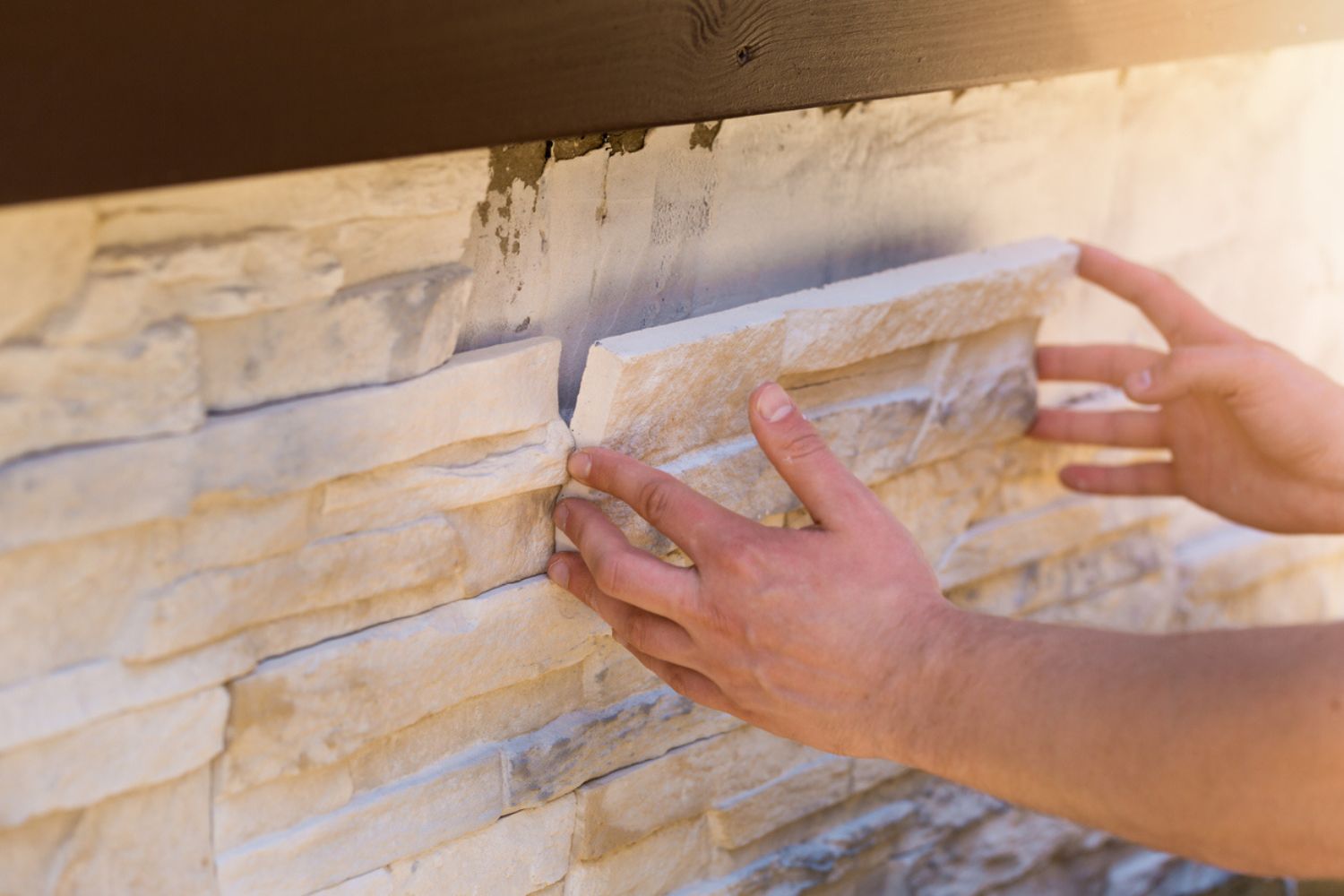
Stone Veneer Siding Installation: DIY vs. Hiring a Professional
Putting in stone veneer siding typically involves removing the existing siding, updating the underlayment, adding waterproofing materials, installing the stone veneer siding, then touching up any existing areas with exterior paint to ensure the finished product isn’t diminished by an older finish. Taking on this project as a DIY job will generally cost about $11 to $18 per square foot, not including the cost of tools and supplies.
While this can be a good way to reduce the overall cost of the project, it will take much longer for a single DIYer to complete and could lead to moisture-related problems if the installation is not completed properly. Instead, homeowners are advised to hire a professional stone veneer siding company to complete this renovation project. Trained professionals know how to install the siding without creating pockets that are vulnerable to water intrusion. They can also obtain the materials and wrap up the project in a much shorter time frame, reducing the risk of damage to the home from wind and rain.
How to Save Money on Stone Veneer Siding Cost
Project budgets are intended to give the homeowner a basic cost range for the job and to help prevent any costly changes that could drive the price of the installation beyond the financial capabilities of the homeowner. To this end, it’s also a good plan to find ways to save on the cost of the stone veneer siding installation, because the more room there is in the budget, the less any unforeseen costs will strain the financial limits of the homeowner. Consider the following cost-saving methods to keep more money in your wallet.
- Select an affordable type of stone veneer. Instead of going with a premium product, such as granite, choose an inexpensive type of stone veneer for the exterior siding project.
- DIY part of the work. Not every part of a stone veneer siding installation requires a substantial amount of experience. DIYers can remove the old siding and prep the area to reduce the labor cost for the job.
- Get multiple estimates. It’s always a good idea to research at least three reputable companies in the area and get estimates from each to compare before hiring an installation company for this work.
- Plan the installation for the offseason. Most exterior renovation projects are completed during the warmer months of the year. This means that homeowners may be able to get discounted prices for projects planned during the early spring or late fall.
Questions to Ask About Stone Veneer Siding Installation
It can seem like it’s less stressful for a homeowner to hire the first reputable stone veneer siding company that comes up on a search and leave everything else to them, but this approach to home renovations can cause many issues when the contractors need to get approval for changes or when the final bill is revealed.
Instead, it’s recommended that homeowners learn more about the installation process, the materials, the installers, and the associated cost of the project. This is possible by asking a list of key questions before, during, and after the completion of the stone veneer siding installation.
- Can I see photos of your previous projects and a list of references?
- How long has the company been in business?
- How many stone siding jobs have you completed, and what’s your specialty?
- What sort of warranties or guarantees does your work include?
- May I see siding samples before you start?
- Are your workers licensed, bonded, and insured?
- How will you prevent water leaks around my windows, doors, roof edges, and exhaust vents?
- Do you use subcontractors?
- Do you install a rain screen and vapor barrier beneath the lath and siding?
- How often should I clean the siding?
- How long should this siding last in my climate?
- How much insulation will the material add to my home?
- Will this type of exterior siding need regular applications of sealant?
- How do you prevent mold growth under the siding?
- Can I see a payment schedule?
- Can I get a written estimate for the materials and labor?
- Will you itemize each cost in the written estimate?
- How long will the project take?
- Will you get permits for this project?
- Who will be supervising inspections?
- What color options are available?
- Can you match the stone siding colors to my home?
- Does your fee include site cleanup?
- Do you offer natural stone siding or faux stone siding?
- Will you attach the siding with or without mortar?
- How should I prepare for the crew’s arrival?
FAQs
Information and understanding are important when it comes to putting together a project budget, hiring an installation company, and verifying the quality of the installation. Homeowners can take a look below at the answers to some of the most frequently asked questions about stone veneer siding in order to learn more about this renovation project.
Q. What are the disadvantages of stone veneer?
The main disadvantages of stone veneer are that it is more costly than most other siding types and also does not have the same lifespan, durability, or resistance as natural stone. Siding made from stone veneer is therefore more vulnerable to moisture, heat, and temperature fluctuations.
Q. How long does stone veneer last?
Stone veneer siding is one of the most durable and long-lasting siding options. After installation, homeowners can expect stone veneer siding to last from about 20 to 75 years with proper care.
Q. Does stone veneer leak?
Generally, stone veneer siding is designed to prevent water from seeping into the home. However, if it is not installed properly, then gaps can be left behind the siding, and water will gradually accumulate. This is called water intrusion. The trapped moisture cannot drain or dry, leading to accelerated mold growth and rot. For these reasons it’s important to ensure the stone veneer siding is installed properly by a trained professional.
Q. How thick is full stone veneer?
The exact size of full stone veneer varies between manufacturers and design options, but on average, full stone veneer is about three to five inches thick.
Q. Is stone veneer worth it?
Stone veneer is an excellent option for the exterior of the home. It looks great and is more lightweight than real stone siding, reducing the strain on the structure of the home. Additionally, stone veneer siding is a good insulator and boasts superior resistance to heat and impact damage.
Q. What is the difference between stone veneer and stone siding?
The primary difference between stone veneer and stone siding is that stone veneer is made by pressing aggregate materials in a mold to create an authentic appearance, while stone siding is made from real stone that has been sliced into thin pieces to create siding.
Sources: Angi, HomeGuide, Costimates

